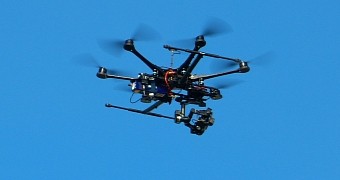At this year's RSA security conference in San Francisco, Dutch security researcher Nils Rodday, currently working for IBM, has revealed a method of hacking high-end drones using cheap custom-built hacking kits that cost around $40 (€36.5).
Rodday conducted his research in this field as a student at the University of Twente in Holland, when a UAV (Unmanned Air Vehicle) manufacturer approached the university to have its products tested.
The UAVs that Rodday got to play with weren't your run-of-the-mill drones, but actual high-end quadcopters sold to police forces, fire departments, and government agencies, for prices ranging from $35,000 to $40,000 (€32,000 to €36,500).
High-tech drones featured two security weaknesses
Rodday says that these UAVs featured two glaring holes in their design. The first was the usage of the WEP WiFi protocol for ground-to-drone communications. This protocol is known to have security weakness and can be cracked in less than a minute.
The second was in the connection between the drone's WiFi receiver and the drone itself, which used an unencrypted radio protocol, allowing an attacker to sniff the commands it receives from its owner.
In his tests, Rodday managed to crack the WEP protocol, effectively taking control of the drone, and later forced the drone to listen only to his commands.
Vulnerable drones cannot be patched
In an interview with Wired, prior to Wednesday's presentation, Rodday also said that the company manufacturing the drones could not patch existing devices since they didn't have an Internet connection or a way to deliver new versions of the firmware to existing equipment. The company plans to use stronger security measures for future products, though, but this may be just a little too late.
This is not the first time when drones have been hacked. In 2013, security researcher Samy Kamkar demonstrated the SkyJack attack, during which another drone could hijack other drones it was flying next to. Also, in June 2015, another security researcher created the Maldrone backdoor specifically for drone devices.
Below is a quick introduction to Rodday's research, which he presented two days ago at the RSA security conference in San Francisco.

 14 DAY TRIAL //
14 DAY TRIAL // 